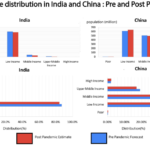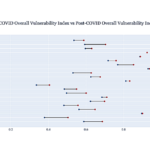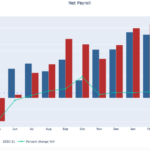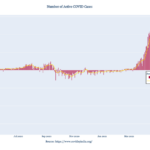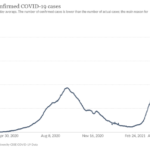Covid-19 and Policy: How Nations Responded to the Challenge
On January 30, 2020, India reported the first case of Covid-19. Less than two months later, on the evening of March 24, 2020, the Union government announced a three-week nationwide lockdown that brought the entire country to a standstill. This first national lockdown of three weeks was then extended thrice (with some relaxations) as India remained in lockdown till May 31, 2020.
The coronavirus pandemic brought with it not only a health emergency but also economic upheaval as the economic ground to a halt. The Union government tried to mitigate the human cost of this lockdown by announcing a slew of measures on March 26, 2020. The finance minister announced a stimulus package to help those affected by the lockdown. A day later, India’s central bank, Reserve Bank of India (RBI) got into the act as it announced a set of measures to soften the economic impact of the lockdown.
Nearly 18 months later, India has seen more than one wave of the pandemic and its economy has been battered by periodic restrictions placed at the state or national levels by different governments. Covid-19 has had a strong impact on all economies around the world and the policy responses have ranged from fiscal, and monetary to financial.
Covid policy responses have also attracted the attention of economists from around the world with the likes of the Centre for Economic Policy Research (CEPR) also publishing papers on Covid economics. This includes the Covid-19 Economic Stimulus Index (CESI) that looks at fiscal, monetary, and balance of payment or exchange rate policy measures adopted by 166 countries and assigns scores to each response. [1] Table 1 shows us the scores for India and some other countries, as per the CESI dataset. It tells us that India’s fiscal stimulus measures were the equivalent of 10.31 percent of India’s GDP. India’s macro financial measures were also nearly 10.86 percent of the GDP. In comparison, USA’s fiscal stimulus was 26.78 percent of its GDP while its macro financial stimulus measures amounted to 14 percent of its GDP. Japan’s fiscal stimulus was 54.9 percent of its GDP while its macro financial stimulus was 16.81 percent of its GDP. All major central banks across the world also made significant monetary policy interventions to counter the effect of the pandemic. This is reflected in all the countries in Table 1 getting assigned a value of 1 in the column ‘Other Monetary’ in the Covid-19 Economic Stimulus Index.
Table 1
| Country | Fiscal (% GDP) | Rate Cut (%) | Macro Financial (% GDP) | Other Monetary | BoP (% GDP) | Other BoP |
|---|---|---|---|---|---|---|
| Australia | 17.05 | 86.67 | 16.66 | 1.00 | 3.33 | 0.00 |
| Bangladesh | 2.46 | 20.83 | 2.73 | 1.00 | 0.00 | 1.00 |
| Brazil | 12.00 | 52.94 | 5.98 | 1.00 | 6.00 | 0.00 |
| China | 6.00 | 15.63 | 8.46 | 1.00 | 0.00 | 1.00 |
| India | 10.31 | 26.98 | 10.80 | 1.00 | 0.15 | 1.00 |
| Japan | 54.90 | 0.00 | 16.81 | 1.00 | 0.00 | 0.00 |
| Pakistan | 5.05 | 47.17 | 4.25 | 1.00 | 0.00 | 1.00 |
| Sri Lanka | 0.81 | 28.72 | 1.00 | 1.00 | 0.43 | 1.00 |
| UK | 11.84 | 86.67 | 39.36 | 1.00 | 0.00 | 0.00 |
| United States | 26.78 | 100.00 | 14.00 | 1.00 | 0.00 | 0.00 |
Source: Covid-19 Economic Stimulus Index [2]
In June 2020, the total stimulus to tackle the Covid-19 crisis was already triple that of the entire 2008-09 recession, according to McKinsey. Governments across the world had allocated over $10 trillion for economic stimulus in just two months.
India’s Covid-19 policy response in international perspective
In this piece, we look at how India’s policy responses to Covid-19 compare with some other large economies in the world.
Figure 1 looks at the fiscal measures taken by countries as percentage of GDP to counter the effects of the Covid-19 pandemic. According to the International Monetary Fund (IMF)’s Covid Policy Tracker, Japan has allocated the highest amount (in percentage of GDP terms), towards fiscal measures at 44.8 percent while the United States, the biggest economy in the world, allocated 27.9 percent of its GDP towards fiscal measures. India allocated 8.7 percent of its GDP towards these measures, which is higher than the average for Emerging Market Economies (EMEs) at 6.7 percent, but far lower than proportions allocated by advanced economies.
Figure 1
Source: IMF Database of Fiscal Policy Responses to Covid-19
Fiscal policy response
India’s GDP contracted by an unprecedented 24 percent in the April to June quarter in 2020. This was the period of the first lockdown in India which was in force for all of April and May with some relaxations in the later phases. For the year 2020-21, India’s GDP contracted by 7.3 percent.
To counter the effects of the pandemic, the first set of measures announced by the government included both cash transfers and food security measures. Outright cash transfers included one-time ex-gratia transfer of INR 1000 to 30 million people (poor widows, aged and the disabled), INR 500 per month for three months to women with Jan Dhan bank accounts. Besides this, the government also included the existing instalment of INR 2000 to farmers under the PM-Kisan scheme in these relief measures.
Other measures included increase in food grain allotment to the poor, wage increase for MGNREGS workers, free LPG cylinders for Ujjwala scheme beneficiaries, and payment towards EPF contributions of both employee, and employer in the organized sector.
As per the IMF, the Indian government’s “above-the-line” measures included government spending (3.5 percent of GDP out of which 2.2 percent was spent in 2020-21), foregone or deferred revenues (about 0.3 percent of GDP within 2020-21), and expedited spending (about 0.3 percent of GDP within 2020-21). “Above the line” measures refer to increases in government expenditures and reductions in tax revenues. These are critical during economic slowdown as they directly impact economic activity via fiscal multipliers.
In the initial stages, these focused on social protection and healthcare. In the later announcements, above-the-line measures included higher capital expenditure by central government, interest-free loans to states and support schemes (like PLI scheme) for priority sectors.
In contrast to above-the-line measures, the government can also spend on “below-the-line measures” which include loans, equity stakes and guarantees. Whether these will be effective or not will depend on their uptake. In India, these included measures to support businesses and shore up credit to several industrial sectors (about 5.3 percent of GDP, as per IMF). It included a scheme for equity infusion in MSMEs, and a viability gap funding scheme for private sector participation in the social sector.
The government also announced measures to ease the tax compliance burden across a range of sectors. Agricultural sector support is mainly for infrastructure development. In the budget for 2021-22, the government increased spending on health, including provision for the country’s Covid-19 vaccination program.
In the US, the US Congress passed the CARES Act in March 2020 that provided a USD 2.2 trillion economic stimulus (11% of GDP) to the American economy. This included nearly USD 300 billion in one-time cash payments to taxpayers in the US, USD 268 billion in expanded unemployment benefits, USD 25 billion in providing food security to the most vulnerable, USD 500 billion in loans to corporations, and USD 339 billion to state and local governments.
In December 2021, the Trump government announced another USD 868 billion (4.1 percent of GDP) for Covid relief. This enhanced unemployment benefits, direct stimulus payments, and provided resources for vaccination and school education.
In March 2021, the Joe Biden government announced the American Rescue Plan Act of 2021, that provided another USD 1.9 trillion (8.8 percent of GDP) for Covid relief.
The US’ Covid relief stimulus is the largest in the world in absolute terms, even though according to the IMF it has spent 27.9 percent of its GDP in providing these fiscal stimulus measures which is significantly lower (in percentage of GDP terms) than Japan which has allocated 44.8 percent of its GDP towards fiscal measures.
Japan’s spending measures included cash handouts of JPY 100,000 to everyone, lumpsum transfer to affected firms (JPY 2 million per SME, JPY 1 million for the self-employed), subsidies for financial institutions, expansion of work subsidies, and incentives to accelerate consumption in service sectors and infrastructure investments.
According to CESI, Japan’s fiscal response measures amount to 54.61 percent of its GDP (the highest in the world), while according to the IMF, they amount to 44.8 percent of its 2020 GDP.
In Germany however, the government’s stimulus programme was not as cash transfer heavy as in the US. While it did include one-off bonus payments for families with children for others it focused more on providing tax relief.
When we compare the fiscal stimulus measures across countries, we find that in no country did cash transfers feature as prominently as in the US.
In contrast, in China, the fiscal measures focused more on extending social assistance programs and minimizing layoffs. According to the IMF, China announced discretionary fiscal measures worth an estimated RMB 4.9 trillion (4.7 percent of GDP). Out of these RMB 4.2 trillion worth of measures were implemented in 2020 itself. This included higher spending on epidemic prevention, production of medical equipment, disbursement of unemployment insurance and extension to migrant workers, tax relief measures, and additional public investment.
According to the IMF, China’s fiscal policy measures to counter Covid-19 impact are to the tune of 6.1 percent of its 2020 GDP, while according to CESI, they are 6 percent of its GDP.
In Figure 2, we look at fiscal response measures in relation to a country’s GDP Per capita (Current, International $). We see that Japan has lower GDP Per capita than both the USA, and UK, but it has spent more on fiscal measures as a percentage of its GDP. In India’s case, we find that it has spent more as a percentage of GDP on fiscal measures to counter the negative effects of Covid-19 than countries like Russia and China which have higher GDP Per capita than India.
Figure 2
Source: Fiscal measures as percentage of GDP (IMF Covid Response Tracker), GDP Per Capita (World Bank) [3]
Monetary and macro financial policy response
In India, the RBI’s monetary policy and liquidity operations were aimed at reducing the impact of the Covid-19 pandemic on the Indian economy. Policy repo rate saw a sizable reduction of 115 basis points (bps) between March and May 2020. Subsequently the Monetary Policy Committee (MPC) of the RBI maintained status quo on the policy rates till February 2021. Given supply chain shocks because of Covid, inflation was a major worry for the MPC and it decided to maintain an accommodative stance for as long as needed to balance out the need for growth with the need to keep inflation under check. The RBI also undertook measures to address liquidity constraints in 2020-21. It provided relief to borrowers and lenders. For example, a six-month moratorium was provided to home loan payers on their EMIs. RBI’s focus remained on easing financial stress, unclogging monetary transmission and credit flows while ensuring financial stability. [4]
Other measures announced by the RBI resulted in cumulative liquidity injection of 5.9 percent of GDP. RBI also provided relief to borrowers and lenders. Moreover, it introduced regulatory measures to push credit flows to the retail sector and MSMEs. It also introduced measures to ease liquidity and financing conditions for Covid-related healthcare infrastructure and services.
The RBI’s monetary policy response to Covid-19 was not different from that of other central banks across the world. Monetary policy measures in countries like the US and China also included steps like mortgage forbearance (USA), Open Market Operations (OMOs) (India and China), rate cuts, and increase in liquidity for MSMEs.
The precursor to the pandemic
The economic response to the pandemic has also been affected by each country’s economic situation as the pandemic appeared on the horizon. The UK saw zero growth between October-December 2019 while it grew by 1.4 percent over 2019. This was among the slowest growth rates for the UK economy since the 2008 financial crisis. UK’s GDP growth was volatile through 2019, largely because of Brexit.
In the United States, 2019 was the tenth consecutive year of economic growth since the contraction it suffered in 2008 and 2009. It grew by 2.3 percent in 2019, which was slower than the 2.9 percent growth it saw in 2018. The US economy also added 2.1 million jobs in the year and unemployment was at a historic low of 3.5 percent, the lowest in 50 years. Thus, the US faced the pandemic from a position of economic strength as compared to the UK which was facing challenges related to Brexit.
In China, the economy facing a trade war with the US, grew by 6.1 percent in 2019. This was the slowest GDP growth rate for China since 1990.
As India prepared to face the pandemic in March 2020, it was coming after historically poor economic performance in the year 2019-20. According to government estimates, the Indian economy grew by only 4 percent in 2019-20.
These economic growth numbers in 2019 or 2019-20 would have influenced each country’s ability to provide fiscal stimulus to the economy. The US economy’s purple patch would have provided their government unprecedented firepower in taking the challenge head-on while India’s poor economic growth numbers would have made the Indian government a little conservative in its approach.
The vaccination race
At more than 37 million cases, United States has been the worst-affected country in the world when it comes to the Covid-19 pandemic. The US economy also contracted by more than 31 percent in the April to June quarter in 2020. However, the US economy has strongly rebounded thanks to its successful vaccination program. As on date, more than 51 percent of its population has been fully vaccinated while another 9.3 percent has been partially vaccinated.
Japan suffered its worst postwar economic performance as it contracted by 27.8 percent in the April-June quarter in 2020 because of the coronavirus pandemic. It saw an overall decline of 4.8 percent in the year 2020. The pandemic also forced the country to postpone the 2020 Tokyo Olympics to 2021. 41 percent of Japan’s population has been fully vaccinated with another 12 percent partially vaccinated.
Covid-19 first struck UK at the end of January 2020 and saw the first peak in April-May 2020. The UK economy contracted by 9.8 percent in 2020, registering the sharpest decline between April-June 2020 of 19.5 percent. It has fully vaccinated more than 62 percent of its population while another nearly 8.7 percent population has been partially vaccinated. Despite having one of the best vaccination numbers in the world, UK has not seen the kind of economic recovery as seen in China or the USA.
With the coronavirus pandemic originating in Wuhan, China, the Chinese economy was the first to bear the brunt of its impact. It contracted by 6.8 percent in the January-March 2020 quarter. After this the economy staged a V-shaped recovery and registered an annual growth rate of 2.3 percent in 2020. China has fully vaccinated 16 percent of its population and another 28 percent has been partially vaccinated.
The Indian economy suffered a contraction in the year 2020-21. India’s GDP contracted by 7.3 percent in 2020-21 with its fiscal deficit touching 9.3 percent. So far 9.4 percent Indians have been fully vaccinated while another 23 percent have been partially vaccinated.
Conclusion
The Covid-19 pandemic has brought with it an unprecedented economic challenge for the world and has strained every country’s fiscal capacity. While some countries like the US have resorted to providing direct cash transfers to the citizens to mitigate the pandemic’s negative effects, others have tried to bank on providing credit facilities while doing very limited cash transfers.
Countries’ fiscal response to the pandemic has also been affected by both their economic performance in the years prior to the pandemic and the severity of the pandemic itself. While the US has been the worst affected country in terms of number of Covid-19 infections, its decade-long good economic performance enabled it to provide an unparalleled fiscal stimulus that banked on cash transfers as a major component. In Europe, on the other hand, a robust social security infrastructure may have reduced the need for direct cash transfers, as noted here. Moreover, as Adam Taylor notes, many European countries paid companies to keep workers on, instead of depending upon cash transfers to unemployed workers.
India has had to face two strong waves of the pandemic on the back of weak economic performance in the last few years. India’s weak economic indicators might be the reason why India’s fiscal response has tax foregone or extension of credit facilities as major components of its stimulus measures. However, its poor vaccination numbers make it susceptible to another debilitating wave of Covid-19 which can put more pressure on India’s economy and require even more stimulus going forward.
[1] Economic policy responses to a pandemic: Developing the Covid-19 Economic Stimulus Index Ceyhun Elgin et al
[2] Fiscal stands for the fiscal policy package as a percent of GDP, Rate cut is the interest rate cut as a percent of the pre-crisis level, Macro-Financial is the monetary stimulus package as a percent of GDP, other monetary is a dummy variable taking the value of 1 if there are other accompanying monetary measures, BoP is the monetary intervention to control the balance of payments and the exchange rate as a percent of GDP and finally, Other BoP is a dummy variable taking the value of 1 if there are other accompanying measures towards stabilizing BoP and exchange rate.
[3] GDP Per Capita at Current Prices in International $ for the year 2020 except for Japan. GDP Per Capita for Japan is for the year 2019. All GDP Per Capita data from World Bank.
If you wish to republish this article or use an extract or chart, please read CEDA’s republishing guidelines.
